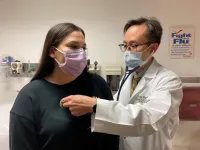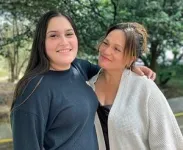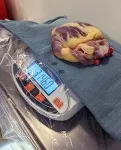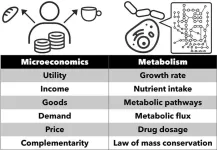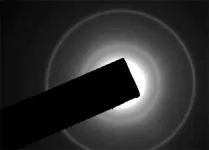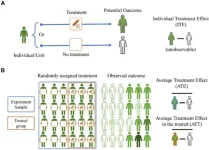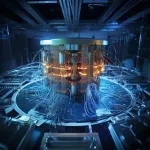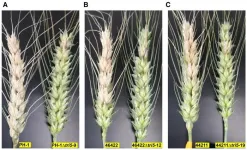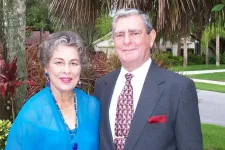(Press-News.org) Doctors in Seattle are reporting a history-making case in which a patient received two donor organs, a liver and a heart, to prevent the extreme likelihood that her body would reject a donor heart transplanted alone. In this innovative case, the organ recipient’s own healthy liver was transplanted, domino-like, into a second patient who had advanced liver disease.
The dual-organ recipient, Adriana Rodriguez, 31, of Bellingham, Washington, has recovered well since the Jan. 14, 2023, procedures, said Dr. Shin Lin, a cardiologist at the UW Medicine Heart Institute. He is the lead author of the paper describing the novel approach, just published in the Journal of Heart and Lung Transplantation.
Heart-liver transplants to one recipient are seldom performed, Lin said. In fact, this was the first such case for UW Medicine surgeons. In cases previously reported in literature, the patients have needed the two grafts to replace both failing organs.
Rodriguez’s case was unprecedented in two ways: Her own liver was healthy, and she received a donor liver only to mitigate the near-certainty, in her medical team’s opinion, that her body would immediately reject the donor heart she desperately needed.
“She met all criteria for transplant, but her antibodies (to the antigens of organ donors) were the highest we’ve ever seen,” Lin said. “Finding an immunologic match for her heart alone was going to be like trying to win the lottery. Essentially she would have needed the donor to be her immunologic twin.”
Rodriguez’s need for a heart transplant stemmed from a spontaneous tear within her coronary artery that occurred Dec. 8, 2022. Such “dissections,” in medical parlance, are rare but not unheard-of among women around the time of pregnancy.
Two weeks earlier, Rodriguez had given birth to her third child at PeaceHealth St. Joseph Medical Center in Bellingham.
“There are thought to be hormonal changes and stress in pregnancy that can make the coronary arteries vulnerable to these tears,” said Dr. Daniel Fishbein, a heart failure specialist on Rodriguez’s team. “In the best-case scenario, a dissection heals without much heart damage and the patient goes home with medications and gets better. But this patient had terrible heart failure.”
Rodriguez’s doctors at PeaceHealth initially treated the coronary artery dissection with an aortic balloon pump to help her heart circulate blood. Then they transferred her to UW Medicine, where doctors found that her dissection had caused widespread, permanent damage to her heart.
In the month that followed, Rodriguez’s team removed the balloon pump and employed other devices to try to supplant her heart’s pumping function.
“The dissection injured her heart a lot. We attempted to remove her from support over time to see if her heart was recovering, and she continued to fail that,” said Dr. Jay Pal, a cardiothoracic surgeon. “We went through a variety of support strategies to try to help her heal without ECMO and without transplant, but ultimately there was no other choice.”
On Dec. 14, doctors connected Rodriguez to an extracorporeal membrane oxygenation system (ECMO). This machine pumps and oxygenates blood, temporarily unburdening the patient’s heart and lungs. ECMO enables some patients to recover strength and forgo additional procedures, but in this case, Pal said, “going on ECMO meant she probably was going to need a transplant to get off ECMO.”
Rodriguez was officially listed for heart transplant on Jan. 5.
With every transplant, doctors measure the prospective recipient’s antibodies to gauge the likelihood of donor organ rejection. Someone whose levels are high is described as being “highly sensitized.”
“Pregnant women are more likely to have high sensitization because when they carry a child, their body develops antibodies against antigens that come from the father,” said Lin. “These antibodies don't attack the fetus, but if you transplant that person, those antibodies will attack the transplanted organ — sometimes within minutes.”
Rodriguez’s workup suggested she had a high likelihood of rejecting an organ from 99% of potential donors. Poring through medical literature for other ideas, Lin found an observational study from 2021 that noted a “profound immunologic protection” seen with a heart-after-liver transplant (HALT) protocol among seven highly sensitized patients who needed both organs.
Although the data pool was too small to instill full confidence, and even though Rodriguez didn’t need a liver, Lin thought the HALT protocol was her best chance to survive. He proposed the idea to the team, with one amendment: Rodriguez’s healthy liver would be transplanted in parallel to another patient who needed that organ. HALT could become HALT-D, for domino.
Several of Lin’s colleagues initially were resistant.
“There was concern that this was an unproven treatment in a complex patient. But there were no other ideas or techniques that would allow this young mother to be free from ECMO and leave the hospital,” Pal said. “Dr. Lin’s unyielding belief that HALT-D would be successful convinced us. Ultimately, Adriana is alive and doing well because of his conviction."
On Jan. 14, organ-procurement agency LifeCenter Northwest notified UW Medicine that two organs had become available from a deceased donor. This set in motion a carefully orchestrated, 17-hour sequence at UW Medical Center-Montlake:
First, Drs. Mark Sturdevant and Ramasamy Bakthavatsalam removed Rodriguez’s liver and placed it on ice, then transplanted her with the donor liver. Drs. Pal and Ionnis Dimarakis then transplanted the donor heart while Sturdevant and Bakthavatsalam transplanted Rodriguez’s liver into a patient in an adjacent operating room.
“We looked at (Rodriguez’s) antibodies almost every day,” Lin recalled. “It was not until 65 days after transplant that her antibodies against these donor organs disappeared altogether. That’s when I felt like I could finally breathe easier. That meant it was an unqualified success.”
Exactly why a donor liver would confer immunoprotection on a donor heart is still a bit of medical mystery, Fishbein suggested.
“I think we don't fully understand the science of transplant immunology. We can learn a lot from patients like this. We need to understand the magic so we can hopefully, someday, repeat it with medications instead of an organ.”
Six months out from her procedures, Adriana Rodriguez offered her thanks:
"There are no words to express my gratitude for my exceptional care — to the doctors and surgeons brainstorming on how to save my life, to my nurses for going the extra mile to make me feel comfortable, and to everyone working on my case that I didn't get to meet.
"I pray no other woman goes through this, but I hope my situation will benefit them and bring them hope," she said.
END
In historic procedure, donor liver protects heart transplant
A UW Medicine team saved a patient with a dual-organ procedure based on a concept about immunoprotection.
2023-07-13
ELSE PRESS RELEASES FROM THIS DATE:
Red pill or blue pill? The critical decision to control the superbugs
2023-07-13
Researchers from Tokyo Medical and Dental University (TMDU) investigate a pharmacist-led intervention to optimize the oral antimicrobial prescriptions in dental setting
Tokyo, Japan - The battle to stop the increase of superbugs in hospitals has been an ongoing struggle for healthcare professionals. Dentists are currently facing a medical challenge that determines the faith of antimicrobial resistance in healthcare settings. To choose the “red pill” means to embrace the painful truth that bacteria are acquiring resistance to many antimicrobials. Meanwhile, the “blue pill” creates ...
The economic life of cells
2023-07-13
A team from the University of Tokyo has combined economic theory with biology to understand how natural systems respond to change. The researchers noticed a similarity between consumers’ shopping behavior and the behavior of metabolic systems, which convert food into energy in our bodies. The team focused on predicting how different metabolic systems might respond to environmental change by using an economic tool called the Slutsky equation. Their calculations indicated that very different metabolic ...
Researchers propose strategy for improving NASICON-type cathode performance
2023-07-13
Manganese-rich NASICON-type materials have attracted widespread attention for developing advanced polyanionic cathodes, primarily driven by their abundant reserves, promising cycling performance, and potentially high operating voltage.
Unfortunately, their charge/discharge profiles exhibit significant voltage hysteresis, which leads to a limited reversible capacity, thereby preventing their application.
Now, however, the situation may be changing due to research by scientists at the Institute of Process Engineering (IPE) and the Institute of Physics of the Chinese Academy of Sciences. They recently identified ...
Drexel’s titanium oxide material lets sunlight drive green hydrogen production
2023-07-13
Clean energy plans, including the U.S. Infrastructure Investment Act’s “Clean Hydrogen Road Map,” are counting on hydrogen as a fuel of the future. But current hydrogen separation technology is still falling short of efficiency and sustainability goals. As part of ongoing efforts to develop materials that could enable alternative energy sources, researchers in Drexel University’s College of Engineering have produced a titanium oxide nanofilament material that can harness sunlight to unlock the ubiquitous molecule’s potential as a fuel source.
The discovery offers an alternative ...
Advancing causal inference in clinical neuroscience research: a call for clarity
2023-07-13
A Perspective published in Volume 3 of the journal Psychoradiology, researchers from Shanghai Jiao Tong University confronted these challenges and advocates for more clarity and transparency in causal analyses. The review distinguishes between traditional statistical analysis and causal inference, highlighting the need for specific causal assumptions, like the Stable Unit Treatment Value Assumption (SUTVA).
Randomized controlled trials (RCTs) are considered the gold standard for estimating causal effects. The authors stress the importance of imitating RCTs in observational studies through quasi-experimental techniques, ...
Longevity biotech startup Gero demonstrates the power of quantum computing in drug design
2023-07-13
Gero, an AI-driven biotech focused on aging and longevity, has demonstrated the feasibility of applying quantum computing for drug design and generative chemistry, which now offers significant promise for the future of healthcare. The research, published in Scientific Reports, outlines how a hybrid quantum-classical machine-learning model was used to interface between classical and quantum computational devices with the goal of generating novel chemical structures for potential drugs — an industry first.
The research paper follows ...
Timing of turkey nesting may not shift with changing climate
2023-07-13
A new study suggests eastern wild turkeys in five southern U.S. states are unlikely to make meaningful changes in the timing of when they begin nesting, even under significant future climate change.
The findings suggest eastern wild turkeys (Meleagris gallopavo silvestris) could be vulnerable to shifts in climate, which could threaten the availability of their food sources, the amount of vegetation cover available to protect them from predators, and other factors.
“There are implications here for turkey populations ...
New toxin facilitates disease infection and spread in wheat
2023-07-13
Although wheat was among the first domesticated food crops, it remains a global dietary staple several millennia later. Grown on every continent except Antarctica, wheat is the second highest produced grain worldwide, with nearly 800,000 metric tons grown each year (Food and Agriculture Organization). However, a fungal pathogen named Fusarium graminearum causes the devastating disease Fusarium head blight (FHB) on wheat and contaminates grains with harmful toxins called trichothecenes. One such trichothecene, called deoxynivalenol (DON), is produced by most F. graminearum strains in the United States, and it is an essential virulence factor that increases the pathogen’s spread ...
FAU receives $11.5 million gift to combat life-threating illness, amyloidosis
2023-07-13
Currently, there is no cure for amyloidosis, a life-threatening disease that can be present throughout the body, including the heart, kidneys, liver and brain. The most common localized form of amyloidosis, which is seen significantly more often, is in the brain. Cerebral amyloidosis, when symptomatic, usually manifests in one of two ways: in Alzheimer’s disease and related dementias and in brain bleeds, which have consequences such as a stroke.
Because amyloidosis does not affect a specific organ, unraveling the underlying cause of amyloid fibril creation – a hallmark ...
Schmidt Marine Technology Partners announces recipients of $3.5 million global sustainable fisheries initiative
2023-07-13
SAN FRANCISCO—Schmidt Marine Technology Partners, a program of the Schmidt Family Foundation, has awarded $3.5 million in grants to ten organizations and universities in seven countries for the development of new tools and innovations that will improve the sustainability of global fisheries, the program announced today.
“Tens of millions of jobs around the world depend on fisheries, and seafood is the primary protein source for 3 billion people,” said Wendy Schmidt, president and co-founder of the Schmidt Family Foundation. “The innovators chosen to receive these grants are ensuring that fishers and ...
LAST 30 PRESS RELEASES:
Making lighter work of calculating fluid and heat flow
Normalizing blood sugar can halve heart attack risk
Lowering blood sugar cuts heart attack risk in people with prediabetes
Study links genetic variants to risk of blinding eye disease in premature infants
Non-opioid ‘pain sponge’ therapy halts cartilage degeneration and relieves chronic pain
AI can pick up cultural values by mimicking how kids learn
China’s ecological redlines offer fast track to 30 x 30 global conservation goal
Invisible indoor threats: emerging household contaminants and their growing risks to human health
Adding antibody treatment to chemo boosts outcomes for children with rare cancer
Germline pathogenic variants among women without a history of breast cancer
Tanning beds triple melanoma risk, potentially causing broad DNA damage
Unique bond identified as key to viral infection speed
Indoor tanning makes youthful skin much older on a genetic level
Mouse model sheds new light on the causes and potential solutions to human GI problems linked to muscular dystrophy
The Journal of Nuclear Medicine ahead-of-print tip sheet: December 12, 2025
Smarter tools for peering into the microscopic world
Applications open for funding to conduct research in the Kinsey Institute archives
Global measure underestimates the severity of food insecurity
Child survivors of critical illness are missing out on timely follow up care
Risk-based vs annual breast cancer screening / the WISDOM randomized clinical trial
University of Toronto launches Electric Vehicle Innovation Ontario to accelerate advanced EV technologies and build Canada’s innovation advantage
Early relapse predicts poor outcomes in aggressive blood cancer
American College of Lifestyle Medicine applauds two CMS models aligned with lifestyle medicine practice and reimbursement
Clinical trial finds cannabis use not a barrier to quitting nicotine vaping
Supplemental nutrition assistance program policies and food insecurity
Switching immune cells to “night mode” could limit damage after a heart attack, study suggests
URI-based Global RIghts Project report spotlights continued troubling trends in worldwide inhumane treatment
Neutrophils are less aggressive at night, explaining why nighttime heart attacks cause less damage than daytime events
Menopausal hormone therapy may not pose breast cancer risk for women with BRCA mutations
Mobile health tool may improve quality of life for adolescent and young adult breast cancer survivors
[Press-News.org] In historic procedure, donor liver protects heart transplantA UW Medicine team saved a patient with a dual-organ procedure based on a concept about immunoprotection.
